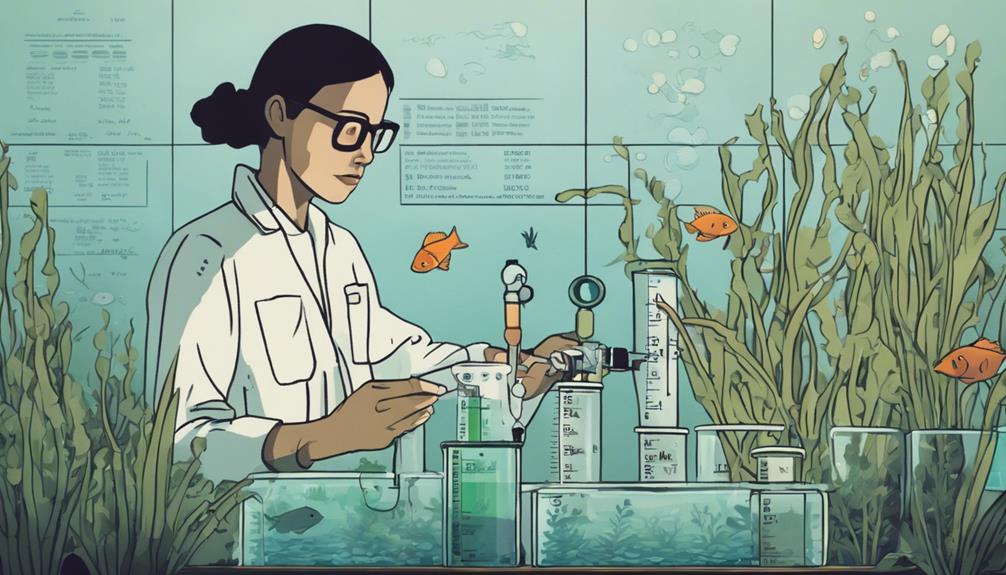You test pond water quality at home to prevent catastrophic consequences like algae blooms, oxygen depletion, and fish die-offs. Regular testing helps detect potential issues before they escalate, ensuring a thriving environment for aquatic life. You'll identify underlying problems affecting the ecosystem and take corrective measures to maintain ideal water quality. By testing at home, you'll be able to respond promptly to signs of poor water quality, such as murky water or foam on the surface. Understanding your pond's water quality is the first step towards creating a balanced and healthy ecosystem – and you must take that step now.
Table of Contents
Key Takeaways
- Regular water testing detects potential water quality issues before they become major problems, ensuring a healthy pond ecosystem.
- Monitoring water quality parameters like pH, nutrient levels, and oxygen levels helps identify underlying issues affecting aquatic life.
- Testing pond water quality at home helps prevent water quality issues from escalating into severe problems, reducing the risk of fish death and algae blooms.
- Identifying poor water quality signs, such as murky water or algae growth, enables prompt corrective action, maintaining a thriving environment for aquatic life.
- Regular water testing at home saves time and money by preventing costly and time-consuming corrections down the line.
Importance of Regular Water Testing
Regular water testing is crucial to safeguard the health and well-being of aquatic life, as it helps detect potential water quality issues before they become major problems.
As a pond owner, you want to guarantee your pond water quality is ideal for your fish and other aquatic organisms. To achieve this, you need to monitor pH levels, nutrient levels, and other parameters regularly.
Using a water test kit, you can determine if your pond water is healthy or not. If the test results indicate an imbalance, you can take corrective measures such as performing a partial water change or adjusting your filtration system.
Regular water testing also helps you identify any underlying issues that may be affecting your pond's ecosystem. By staying on top of your pond's water quality, you can prevent problems before they escalate, maintaining a thriving environment for your aquatic friends.
Common Signs of Poor Water Quality
What're the telltale signs that your pond water quality is heading south? As a responsible pond owner, it's vital to recognize the indicators of poor water quality to take prompt action.
During pond water testing, you might notice algae blooms that discolor the water, making it unappealing and potentially toxic to aquatic life. Murky water, often resulting from oxygen depletion, is another common sign of poor water quality.
Foam or scum on the water surface can also indicate poor water quality, typically caused by decaying organic matter. Dead fish or a lack of wildlife around the pond are clear signs that something is amiss.
You might notice that plants and algae are overgrowing, leading to a decrease in pH and an increase in ammonia in the water. If the water isn't moving, it can exacerbate these issues.
Understanding Water Quality Parameters

When testing pond water quality, you'll need to analyze several key parameters that directly impact the health and well-being of your aquatic ecosystem. These parameters provide valuable insights into the overall condition of your pond, helping you identify potential issues before they become major problems.
Parameter | Ideal Range | Potential Impact |
| — | — | — |
|---|---|---|
| pH | 6.0-9.0 | Stressful for fish outside this range |
| Total Dissolved Solids (TDS) | <1,000 mg/L | High levels indicate pollution |
| E. coli | <126 colonies/100 mL | High levels pose health risks |
| Aluminum | <0.1 mg/L | Toxic to aquatic life |
Monitoring these parameters through regular water tests is essential for effective pond management. For instance, high levels of aluminum, iron, and manganese can have devastating effects on your pond's ecosystem. By understanding these parameters, you can take proactive steps to maintain a healthy and thriving aquatic environment. Remember, regular water testing is key to identifying potential issues before they become major problems.
Maintaining Healthy Pond Conditions
By understanding the key water quality parameters, you can now take targeted actions to maintain healthy pond conditions, such as implementing aeration systems or adjusting nutrient inputs.
A well-balanced pond ecosystem relies on a delicate interplay between water, plants, and fish. Aquatic plants help to absorb excess nutrients, reducing algae growth and maintaining clear water. Meanwhile, fish contribute to the pond's nutrient cycle, and a healthy fish population indicates a thriving ecosystem.
To maintain ideal pond water quality, you must monitor and adjust nutrient levels, ensuring that they don't exceed the capacity of your pond's natural processes.
This may involve introducing beneficial bacteria, adjusting fertilizer applications, or incorporating plants that absorb excess nutrients. Additionally, maintaining adequate water surface area and circulation can help to prevent stagnation and promote healthy water exchange.
Taking Action Against Water Quality Issues

Implementing corrective measures promptly is essential to preventing water quality issues from escalating into severe problems that can harm your pond's ecosystem.
As a responsible pond owner, it's vital to take action against water quality issues before they spiral out of control.
When faced with water quality issues, you can:
- Establish aeration or circulation systems to boost dissolved oxygen levels, supporting aquatic life
- Apply algaecides or herbicides to control nuisance algae growth, indicating nutrient imbalance or pollution
- Implement nutrient-reducing measures, such as buffer strips or fertilizers, to mitigate the effects of excess nutrients on pond water quality
Frequently Asked Questions
Why Is It Important to Test Pond Water?
As you dip your toe into the pond's tranquil surface, remember that beneath the calm lies a delicate ecosystem balance. You test pond water to guarantee that aquatic life thrives, water clarity shines, and nutrient levels support fish health, avoiding harmful algae and oxygen depletion that disrupt biological cycles.
Do You Need to Test Pond Water?
You need to test pond water to maintain Pond Health, guarantee Water Clarity, protect Fish Welfare, fulfill Homeowner Responsibility, mitigate Environmental Impact, prioritize Personal Safety, and preserve Water Aesthetics, ultimately supporting thriving Aquatic Life.
Why Is It Important to Test Water Quality?
You test water quality to protect aquatic life, human health, and the environment, as poor quality water can disrupt chemical reactions, biological balance, and nutrient levels, leading to ecological consequences, cloudy water, and devastating effects.
How Often Should Pond Water Be Tested?
You should test your pond water regularly, ideally on weekly cycles, considering seasonal changes, to maintain good water clarity, aquatic life, and nutrient levels, while monitoring filter efficiency and daily fluctuations in weather patterns.
Conclusion
As you take care of your pond, remember that an ounce of prevention is worth a pound of cure.
Regularly testing your pond water quality at home is essential to maintaining a healthy ecosystem.
By staying on top of water quality issues, you'll avoid costly and time-consuming problems down the line.
Don't wait until it's too late – take control of your pond's health today and reap the rewards of a thriving aquatic environment.

